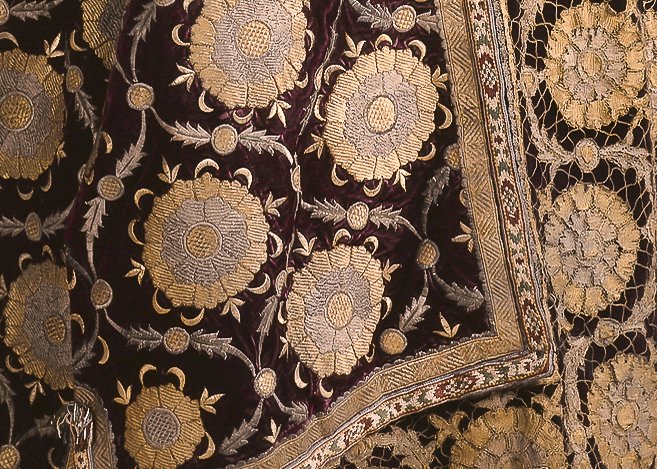A COUNTESS’S COLUMNS
Mme Lafon’s Paris bedroom featuring the repurposed Neo-Egyptian boiseries and lotus motif columns that once adorned a small theater at Comtesse Greffulhe’s Château de Bois-Boudran • Interior design by Jacques Grange • Photograph Circa 1988 • Image courtesy of Philippe Girardeau via Private Paris : The Most Beautiful Apartments by Marie-France Boyer
How the fin de siècle fashionista Countess Greffulhe inspired the interior designer Jacques Grange’s stunning Neo-Egyptian decor for Mme Lafon’s Parisian pied-à-terre in Montmarte nearly a century later... The Countesse’s aesthetic legacy lived on through Grange’s repurposing of her original painted boiseries and lotus motif columns in the Pigalle apartment, as featured in a 1978 issue of Architectural Digest.
Contemporary fashion illustrator Aurore de la Morinerie's drawing of Maison Worth’s tea gown from 1897 • Image courtesy of La Mode Retrouvée : Les Robes Trésors de la Comtesse Greffulhe by Olivier Saillard in association with the 2015 exhibition at the Palais Galliera, Paris
”The Countess Greffulhe believed in the artistic significance of fashion,” said Steele. “And although she patronized the greatest couturiers of her time, her style was very much her own. Today, when fashion is increasingly regarded as an art form, her attitude is especially relevant.” When Marcel Proust wrote his novel In Search of Lost Time (À la recherche du temps perdu), the Countess Greffulhe inspired his immortal character, Oriane, the Duchess de Guermantes... A pioneering fund-raiser, the countess was a patron of Sergei Diaghilev's Ballets Russes, and in the years prior to the First World War her fashions also gravitated toward avant-garde Orientalist styles.” • Dr. Valerie Steele & The Museum at FIT
Mme Lafon’s Paris bedroom featuring the repurposed Neo-Egyptian boiseries and lotus motif columns that once adorned a small theater at Comtesse Greffulhe’s Château de Bois-Boudran • Interior design by Jacques Grange
”Mme Lafon’s bedroom is an amusing poetic conjuration of the neo-Egyptian style, so popular in fin de siècle Paris... There are, for example, those Egyptian boiseries that once graced a small theatre on the country estate of the Comtesse Greffulhe (Château de Bois-Boudran). The countess had them specially made for one of the visits of Edward VII to her château. However, in recent years the boiseries lay disassembled in the shop of an antiques dealer. When Jacques Grange came across them he instantly saw the use they could be put to in Mme Lafon’s new apartment. They are now in her bedroom-the adjoining bathroom decorated with Egyptian lotus and scarab motifs...” • Architectural Digest November 1978
Contemporary fashion illustrator Aurore de la Morinerie's drawing of Comtesse Greffulhe modeling La Robe aux Lys by Maison Worth • Image courtesy of La Mode Retrouvée : Les Robes Trésors de la Comtesse Greffulhe by Olivier Saillard in association with the 2015 exhibition at the Palais Galliera, Paris
A detail of the embroidered fabric from the khalat which Jean-Philippe Worth adapted into an evening cloak for Comtesse Greffulhe • Circa 1896
The Comtesse Élisabeth Greffulhe posing in her repurposed Russian ceremonial court robe called a khalat, given to her by Tsar Nicholas II during a visit to Paris. Greffulhe’s couturier Jean-Philippe Worth transformed the robe into an evening cloak as shown in the photograph • Circa 1896 • Otto Wegener • Image courtesy of La Mode Retrouvée : Les Robes Trésors de la Comtesse Greffulhe by Olivier Saillard in association with the 2015 exhibition at the Palais Galliera, Paris
Mme Lafon’s Paris apartment featuring a 1910 demilune mirror reflecting the Neo-Egyptian leaded glass doors • Interior design by Jacques Grange • Photograph Circa 1988 • Image courtesy of Philippe Girardeau via Private Paris : The Most Beautiful Apartments by Marie-France Boyer
The Comtesse Élisabeth Greffulhe posing in an evening gown • Circa 1887 • Paul Nadar • Image courtesy of La Mode Retrouvée : Les Robes Trésors de la Comtesse Greffulhe by Olivier Saillard in association with the 2015 exhibition at the Palais Galliera, Paris
Contemporary fashion illustrator Aurore de la Morinerie's illustration of a textile belonging to one of Comtesse Greffulhe’s garments • Image courtesy of La Mode Retrouvée : Les Robes Trésors de la Comtesse Greffulhe by Olivier Saillard in association with the 2015 exhibition at the Palais Galliera, Paris
Mme Lafon’s Paris bedroom featuring the repurposed Neo-Egyptian boiseries and lotus motif columns that once adorned a small theater at Comtesse Greffulhe’s Château de Bois-Boudran • Interior design by Jacques Grange • Image courtesy of Pascal Hinous via Terence Conran's New House Book : The Complete Guide to Home Design
Contemporary fashion illustrator Aurore de la Morinerie's illustration of Comtesse Greffulhe • Image courtesy of La Mode Retrouvée : Les Robes Trésors de la Comtesse Greffulhe by Olivier Saillard in association with the 2015 exhibition at the Palais Galliera, Paris
Another view of Mme Lafon’s Paris bedroom featuring the repurposed Neo-Egyptian boiseries and lotus motif columns that once adorned a small theater at Comtesse Greffulhe’s Château de Bois-Boudran • Interior design by Jacques Grange
Maison Worth’s 1896 La Robe aux Lys evening gown made for Comtesse Greffulhe on display at La Mode Retrouvée : Les Robes Trésors de la Comtesse Greffulhe, the 2015 exhibition at the Palais Galliera, Paris
Mme Lafon’s Paris bedroom featuring the repurposed Neo-Egyptian boiseries and lotus motif columns that once adorned a small theater at Comtesse Greffulhe’s Château de Bois-Boudran • Interior design by Jacques Grange • November 1978 • Image courtesy of Pascal Hinous via Architectural Digest
Contemporary fashion illustrator Aurore de la Morinerie's drawing of Maison Worth’s La Robe aux Lys evening gown from 1896 • Image courtesy of La Mode Retrouvée : Les Robes Trésors de la Comtesse Greffulhe by Olivier Saillard in association with the 2015 exhibition at the Palais Galliera, Paris
The Comtesse Élisabeth Greffulhe modeling La Robe aux Lys by Maison Worth • Circa 1896 • Paul Nadar • Image courtesy of the Palais Galliera, Paris
A dark blue cut velvet on green satin tea gown by Maison Worth • Circa 1897 • Image courtesy of La Mode Retrouvée : Les Robes Trésors de la Comtesse Greffulhe by Olivier Saillard in association with the 2015 exhibition at the Palais Galliera, Paris
Contemporary fashion illustrator Aurore de la Morinerie's drawing of Maison Worth’s tea gown from 1897 • Image courtesy of La Mode Retrouvée : Les Robes Trésors de la Comtesse Greffulhe by Olivier Saillard in association with the 2015 exhibition at the Palais Galliera, Paris
The specially made Neo-Egyptian boiseries and lotus motif columns showcased in Comtesse Greffulhe’s theatre at Château de Bois-Boudran • Circa 1905
A dark blue cut velvet on green satin tea gown by Maison Worth • Circa 1897 • Image courtesy of the Palais Galliera, Paris




















